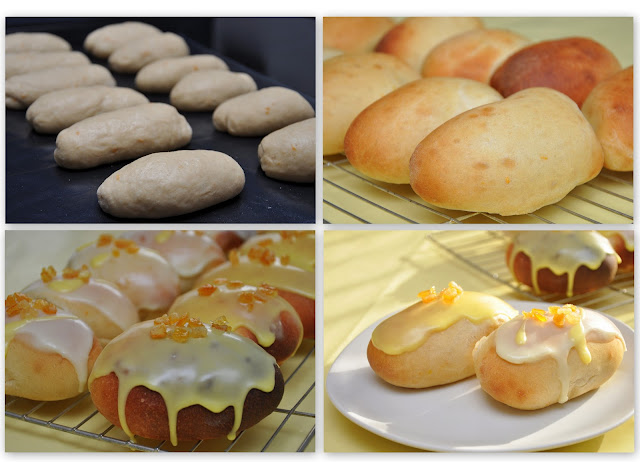Here is another way of presenting rich sweet dough ... very wet and sticky dough ....
... and it was quite difficult to shape the dough into "fingers."
As you see they are more "chubby fingers" than they really should have been, but they tasted good....
So, it's all good, isn't it?
Ingredients
- 255g strong white flour
- 250g plain flour
- 125ml warm water
- 125m warm milk
- 1
x 7g sachet fact-action dried yeast
- 1 tsp fine sea salt
- 50g caster sugar
- the zest of 1 lemon or orange
- 1
free-range egg, beaten
- 50g butter, cut into cubes
- For icing
- 50g icing sugar
- ½ lemon, juice
Method
1. Place the flour, water, milk, yeast, salt, sugar
and lemon (or orange) zest into a large bowl and mix.
Add the
beaten egg and butter and continue to mix until the mixture comes together as a
sticky dough.
2. Tip the dough onto a lightly floured work surface
and knead for ten minutes, or until the dough is smooth and elastic.
3. Lightly oil a bowl with a little of the vegetable
oil.
4. Place the dough into the bowl and turn it until it is
covered in the oil. Cover the bowl with cling film and set aside in a warm
place for one hour, or until the dough has doubled in size.
5. Lightly grease two baking trays.
6. Knock the dough back to its original size and turn
it out onto a lightly floured work surface. Divide the dough into twelve portions, shape them into long oval and place onto the baking trays. Ensure the buns are well spaced. Cover with a tea towel and set aside to prove for 30
minutes.
7. Preheat the oven to 220C/425F/Gas 7.
8. Bake the buns in the oven for 10-15 minutes or
until well risen and golden-brown. Remove the buns from the oven and set aside
to cool on a wire rack.
9. Meanwhile for the icing, mix the icing sugar and
lemon juice (and food colouring if you like) together in a bowl until smooth.
10. Once the buns have completely cooled, spread the
icing on top of them and set aside until the icing has hardened. Decorate with orange/lemon peal.








